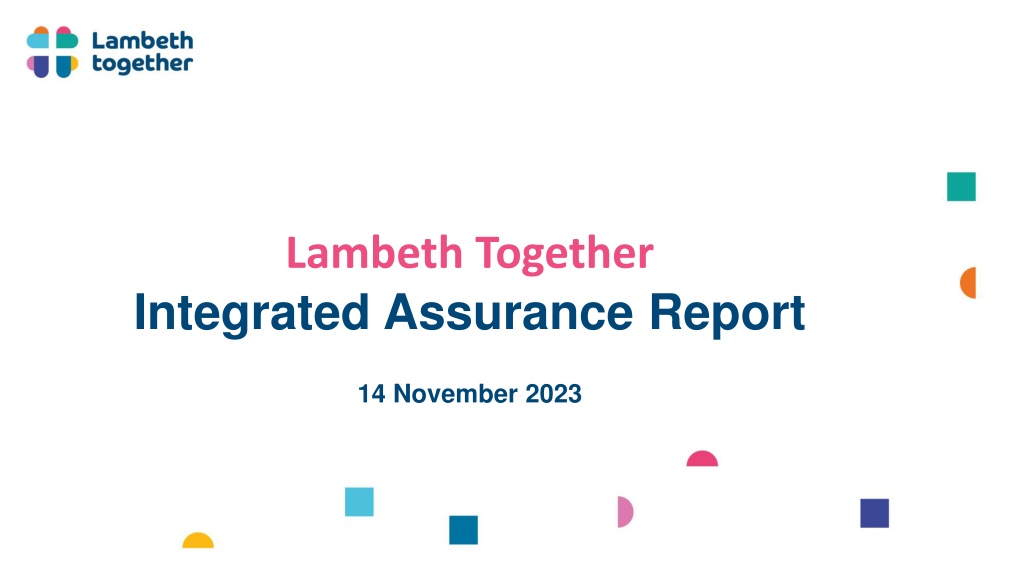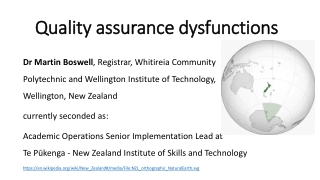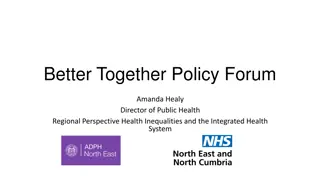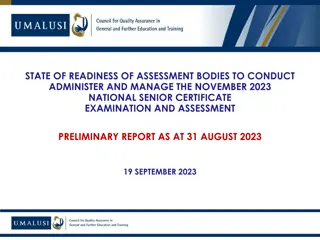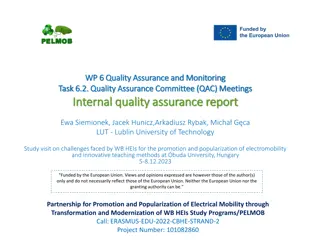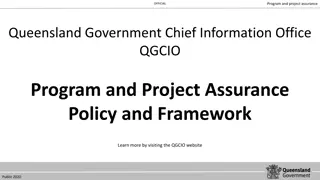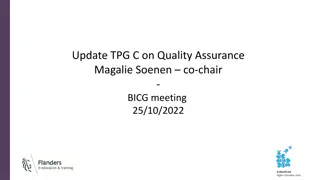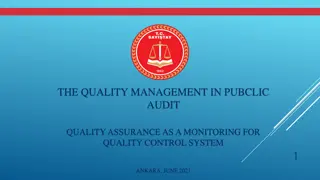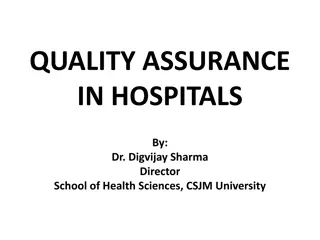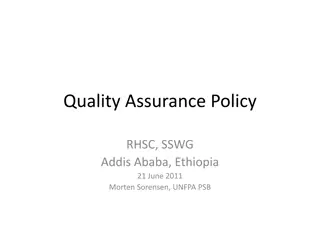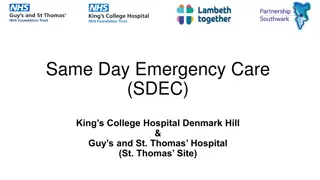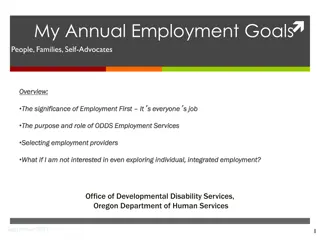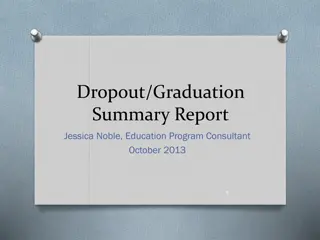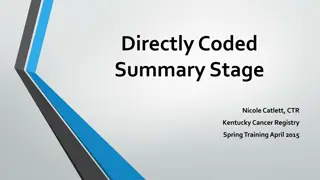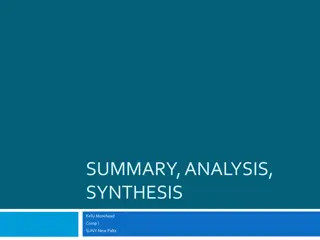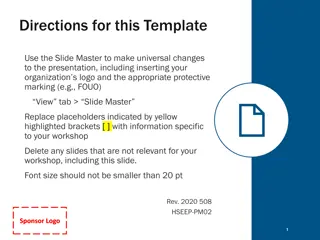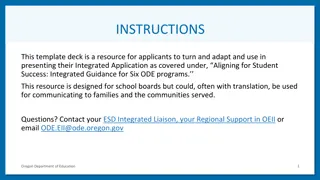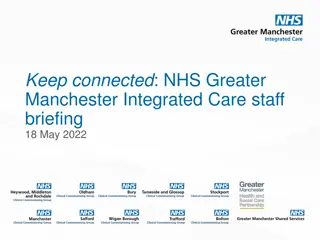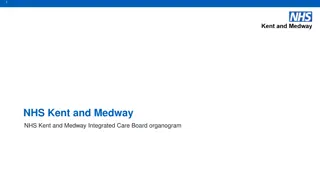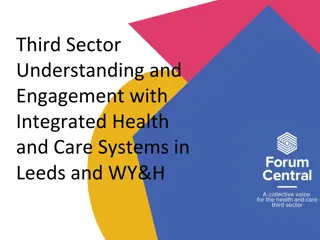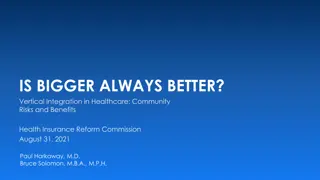Lambeth Together Integrated Assurance Report Summary
Lambeth Together Integrated Assurance Report covers various areas such as finance, quality, and health care plan scorecard. The report includes insights on assurance, foreword, and other key aspects. The report also introduces a scorecard for better tracking and assessment of performance.
Download Presentation

Please find below an Image/Link to download the presentation.
The content on the website is provided AS IS for your information and personal use only. It may not be sold, licensed, or shared on other websites without obtaining consent from the author. Download presentation by click this link. If you encounter any issues during the download, it is possible that the publisher has removed the file from their server.
E N D
Presentation Transcript
Lambeth Together Integrated Assurance Report 14 November 2023
Contents Page Introduction Slide number 3 Foreword Other areas of Assurance Slide number 28 Finance Lambeth Together health and care plan Scorecard Slide number 31 Quality 5 Introducing a Scorecard 38 Risk 6 A: People maintain positive behaviours that keep them healthy 43 Integrated Health and Care Directorate Business Plan South East London ICB Corporate Objectives & delegated assurance metrics 7 B: People are connected to communities which enable them to maintain good health 45 8 C: People are immunised against vaccine preventable diseases 9 D: People have healthy mental and emotional wellbeing 10 E: People have healthy and fulfilling sexual relationships and good reproductive health 11 F: People receive early diagnosis and support on physical health conditions G: People who have developed long term health conditions have help to manage their condition and prevent complications H: When emotional and mental health issues are identified; the right help and support is offered early and in a timely way I: People have access to joined-up and holistic health and care delivered in their neighbourhoods J: People know where to go to get the right help, and are treated at the right time, in the right place, for their needs K: Older adults are provided with the right health and care support at the right time, live healthy and active later lives and are supported to age well L: Women have positive experiences of maternal healthcare and do not experience a disproportionate maternal mortality rate M: People with learning disabilities and/or autism achieve equal life chances, live as independently as possible and have the right support from health and care services N: People using mental health support services can recover and stay well, with the right support, and can participate on an equal footing in daily life O: People who are homeless, or at risk of becoming homeless, (including rough sleepers and refugees) have improved health 13 15 18 19 22 23 24 25 27
Foreword (1/2) We are now at an important milestone, marking six months since the launch of our comprehensive five-year Health and Care Plan 'Our Health Our Lambeth . As a Care Partnership, we have committed to a broad range of activities and 15 key outcomes that will feed into the successful delivery our 3 core aspirations for the health and care of our Lambeth patients and residents: 1. People lead healthy lives and have good physical and emotional health and wellbeing for as long as possible 2. Physical and mental health conditions are detected early and people are supported and empowered to manage these conditions and avoid complications 3. People have access to and positive experiences of health and care services that they trust and meet their needs With recent appointments to a number of leadership roles now firmly established; we are working at pace to set out the pathway and ensuring we are on track with our overarching goal of tackling unfair and avoidable differences in health between different groups and supporting them to lead healthier lives. As we forge our way with delivery of the plan, we also acknowledge that the economy and public sector funding is constrained and will likely remain so over the next five years. Much of our resources are allocated through local government and the NHS and who are grappling with inflation, cost pressures, efficiency savings and continued industrial action. We can also expect the next few months will see additional strain as we prepare for seasonal winter pressures. Most notably, the ICB is facing a 30% real terms reduction in running cost required by 2025/26 which has a direct impact on our short and long term plans as we monitor and mitigate on an ongoing basis to ensure expenditure is within the available resources to maintain our commitment to residents. Despite the challenges we are facing as a sector, our 3 Delivery Alliances; Children and Young People Alliance, Living Well Network Alliance and the Neighbourhood and Wellbeing Delivery Alliance, working in tandem with our focused Programmes; Homeless Health, Sexual Health, Staying Healthy, Learning Disabilities and Autism and Substance Misuse continue to navigate these pressures with the unwavering support of our NHS and VCS partners. We acknowledge and understand that this is just the start, and we intend to evaluate, learn, reflect, and refine as we go, working collaboratively to achieve actions, which are collectively owned across our partnership.
Our Health, Our Lambeth Lambeth Together health and care plan 2023-28
Introducing a Scorecard This iteration of the report now presents the Lambeth Health and Care Plan impact measures in a Scorecard format. This represents our initial effort to offer a concise, easily digestible overview of our progress in relation to the plan. By presenting the key metrics in this format, we aim to make it more accessible for readers to grasp our progress, sparing them the need to sift through the extensive details and intelligence underpinning our impact measures. It's essential for readers to acknowledge the limitations of the data presented in this manner. The red/green rating, while valuable, may not fully encapsulate the complexity of our performance, as it predominantly compares the most recent reported status with the previous period. Since performance can fluctuate from month to month, the presented data may lack statistical significance. Moreover, it does not provide insight into how close a metric is to meeting the desired goals. Additionally, the scorecard should be considered in conjunction with the contextual narrative provided within the report. This scorecard has been swiftly developed in response to the need for a concise assurance summary for the Health and Care Plan. Nevertheless, we recognise the need for further refinement to enhance the scorecard's sophistication in presenting these measures in the future. Note: Not all impact measures are able to be presented in a scorecard format. For additional detail, please refer to the appendix document
A. People maintain positive behaviours that keep them healthy Alliance and Programmes Staying Healthy (owner) with contributions from LWNA, LDA, and Sexual Health programmes Update Month November 2023 Previous period Position* What does good look like indicator ID Lastest period position vs previous Period* Lastest overall position Overall position vs Baseline Measure Latast period Baseline comments Number of appropriate referrals from primary care to the range of weight management support programmes Baseline = estimated cumulative position in 22/23 based on 22/23 outturn A3 Sep-23 264 215 49 1,879 1,398 481 Increase A4 number of respondents completing DrinkCoach survey Sep-23 18 16 2 84 575 -491 Baseline = cumulative position at same point in 22/23 Increase A3 Number of appropriate referrals from primary care to the range of weight management support programmes available - No update for this LTAG meeting. A4 Number of respondents completing DrinkCoach survey and monitor the proportion of people flagged as having a 'possible dependence - : The number of engagement with AUDITS (alcohol test) and coaching remains low in both quarters. Though Q2 shows a slight increase in numbers the progress against the outcome is low. A6 Number of people accessing and engaging in structured treatment programmes - No update for this LTAG meeting. What does the data/intelligence indicate around progress against the outcome? A3 Number of appropriate referrals from primary care to the range of weight management support programmes available - : No update for this LTAG meeting. Does the data/intelligence identify any health inequalities and whether they are reducing? A4 Number of respondents completing DrinkCoach survey and monitor the proportion of people flagged as having a 'possible dependence -The data shows there are gaps of engagement with demographics. Therefore it is unable to measure whether health inequalities are reducing. A6 Number of people accessing and engaging in structured treatment programmes - No update for this LTAG meeting. A3 Number of appropriate referrals from primary care to the range of weight management support programmes available - No update for this LTAG meeting. What are the challenges hindering any progress and are there actions which can be taken to address these? A4 Number of respondents completing DrinkCoach survey and monitor the proportion of people flagged as having a 'possible dependence -There has not been any marketing by the provider in Lambeth about the current offer. Commissioners are working with the provider to raise awareness of the current offer with a marketing strategy. The provider has engaged with social prescribers, community groups and the Health & Wellbeing Bus as directed by Commissioners. Awareness has been shared with Primary Care. A6 Number of people accessing and engaging in structured treatment programmes - No update for this LTAG meeting. A4 Number of respondents completing DrinkCoach survey and monitor the proportion of people flagged as having a 'possible dependence -The ongoing needs assessment indicates that a demand exists within Lambeth for DrinkCoach. Additional Comments 6
B. People are connected to communities which enable them to maintain good health NWDA (owner) with contributions from CYP and Staying Healthy Alliance and Programmes Update Month November 2023 Previous period Position* What does good look like indicator ID Lastest period position vs previous Period* Lastest overall position Overall position vs Baseline Measure Latast period Baseline comments B1 number of social prescribing unique contacts Sep-23 597 560 37 3,626 3,206 420 Baseline = cumulative position at same point in 22/23 Increase Residents wellbeing, use of community assets and social cohesion B2 Q2 23/24 82% 81% 1% 82% 82% 0% Increase B3 percentage of low-income residents coping financially 23/24 Q2 (Aug) 79.2% 77.9% 1.3% 79.2% 76.2% 3.0% Baseline = 22/23 Q4 Increase B1 Number of social prescribing unique contacts - The number of referrals into Social Prescribing continues to increase, the primary role of social prescribing is connecting individuals into services and community support so an increase in referrals suggests this work continues to actively take place in the borough. However, the number of prescriptions and signposts (to services/ support not provided by the Link Worker (LW)) has decreased from August (106) until present (70). This could suggest due to the nature of referrals LWs are providing more support in house rather than making onward referrals however it is not possible to say. This needs to be monitored as to whether it is a regular pattern and to find out why. What does the data/intelligence indicate around progress against the outcome? B3 Percentage of low-income residents coping financially - Both the percentage and the whole number of people within the council s Low Income Family Tracker identified as coping financially has increased in the past month (only a month s new data is available since the last reporting period). B1 Number of social prescribing unique contacts - Across Lambeth the primary referral reasons are housing (200 referrals), accessing support services (252), financial advice (152) and social isolation (118). LWs working with individuals to address health inequalities is a big part of the service. However, it would be good to monitor repeat referrals (not possible currently with the end of the Elemental contract), if there is a reduction in repeat referrals this would imply the LWs interventions are successful and health inequalities are reducing Does the data/intelligence identify any health inequalities and whether they are reducing? B3 Percentage of low-income residents coping financially - Improving financial resilience is an important social determinant of health. B1 Number of social prescribing unique contacts - The Social Prescribing CRM system Elemental will no longer be operational as of 30/10/23. This system was used by all LWs across Lambeth and provided additional data to Social Prescribing referrals. This will have an impact on the level of data that can be reported on across Lambeth Social Prescribing What are the challenges hindering any progress and are there actions which can be taken to address these? B3 Percentage of low-income residents coping financially - The financial wellbeing of residents continues to be challenged due to wider economic factors linked primarily to austerity, inflation and the welfare benefits system not keeping pace with the costs of essentials (e.g. Universal Credit (allowances and two-child policy), the freezing of Local Housing Allowance, Healthy Start Vouchers being insufficient to meet the cost of infant formula). The council has in place a comprehensive evidence-informed cost of living response plan to mitigate the impact of the crisis for our most vulnerable residents in 2023/24. All elements of that programme are in delivery. Since the last reporting period the council has successfully implemented an approach to auto-awarding free school meals to eligible Lambeth households with children in Lambeth schools this has resulted 340 young people being awarded a free school meal (est. value 740 p/a) and an additional 750k of additional deprivation related funding for Lambeth schools. Work is underway to pilot a project targeting cost of living support at residents with health conditions worsened by the cold during the winter. 7
C. People are immunised against vaccine preventable diseases Staying Healthy (owner) with contributions from NWDA Alliance and Programmes Update Month November 2023 Previous period Position* What does good look like indicator ID Lastest period position vs previous Period* Lastest overall position Overall position vs Baseline Measure Latast period Baseline comments Proportion of Lambeth registered children by age 2 that have received all primary immunisations and 1 dose of MMR C1 23/24 Q1 85.3% 84.3% 1.0% 85.3% 84.0% 1.3% Baseline = same period last Year Increase We are awaiting final publication for quarter 2 COVER childhood immunisation uptake, but pre-published data indicates that uptake is similar to quarter 1 with varying uptake amongst registered practice lists. What does the data/intelligence indicate around progress against the C!9 vaccination as at 30th October was similar within Lambeth to other South East London Boroughs (25%). (3rd highest of 6) with uptake being highest amongst our Care home residents and workers (61%). outcome? Flu uptake for target cohorts as at 30th October was 19% with 42% of our population over the age of 65 receiving a vaccination. Data is being shared on uptake for Covid 19 booster uptake at PCN level across London for residents with severe mental illness and learning disabilities which will be looked at via our Vaccination and Immunisations operations group. Does the data/intelligence identify any health inequalities and whether they are reducing? Recently shared London level data continues to show that uptake of the autumn winter C19 booster is lower amongst black African and Caribbean populations and clear gradient of lower uptake in more deprived Indices of Multiple Deprivation (IMD) deciles to higher uptake in less deprived decile. As at 2nd November, our GP Federation report indicated that 1,931 (51%) of our housebound population had received a flu vaccination and 1,726 (45%) had received a flu vaccination. School age vaccination programme requires parents to return consenting forms to the provider even when they decline the vaccination offer. This is important to enable planning and efforts to tackle inequity in uptake. We continue to experience challenges in achieving 100% return of consent forms; the ask to CYP (Schools / Education) is to encourage schools to engage with the School-Age Programme by promoting on-site vaccinations and encouraging uptake, including the return of consent forms, even when parents decline the vaccination offer. What are the challenges hindering any progress and are there actions which can be taken to address these? One of the challenges for increasing childhood immunisation is that pre-published COVER data has up until now not been available and so monitoring uptake during the quarter has not been possible. To address this, we have recently managed to get agreement from NHS England share the data with us earlier to enable us to be more proactive in addressing areas of low uptake. Funding from NHSE for a community model is being piloted where general practices can refer families who have concerns around childhood vaccinations or who have been unable to be contacted to the community team who be able to give dedicated time to contact the family and discuss concerns. It is hoped that this will increase uptake. 8
D. People have healthy mental and emotional wellbeing LWNA and CYPA (owners) Alliance and Programmes Update Month November 2023 Previous period Position* What does good look like indicator ID Lastest period position vs previous Period* Lastest overall position Overall position vs Baseline Measure Latast period Baseline comments In 22/23 there were 169 attendances at Lambeth Suicide Prevention Training,Suicide Prevention Level 1 (Adults - V4),Raising Awareness of Mental Health. Assume that half of those were undertaken in H2 hence basinel of 85 number of community organisations and volunteers undertaking mental health awareness and suicide prevention training. D2 Q2 23/24 31 91 -60 122 85 37 Increase Number of People Entering into Treatment for Integrated Talking Therapies proportion of people people referred starting treatment within 6 weeks proportion of people who complete treatment and recover Target for July 23 was 977. Cumulative Target Apr-Jul 23 = 3,880 D3 Oct-23 870 980 -110 4,087 3,880 207 Increase D3 Oct-23 99% 97% 2% N/A N/A N/A Target for 23/24 is 75% Increase D3 Oct-23 56% 49% 7% N/A N/A N/A Target for 23/24 is 50% Increase No update since last report. D2 Number of community organisations and volunteers undertaking mental health awareness and suicide prevention training - In FY22-23 Mental health awareness and suicide prevention training was delivered to 169 attendees, including residents, council staff in front line roles and staff from the voluntary and private care sectors. D3.1 Lambeth Talking Therapies service access rate - Monthly IAPT access numbers are highly variable but clearly improving. D3.2 proportion of people referred starting treatment within 6 weeks - Waiting numbers are stable. Waiting times are slightly up in FY 23-24 M4 July but are stable over the longer term. D3.3 proportion of people who complete treatment and recover - The recovery rate overall trend is clearly downwards, moving away from the target. What does the data/intelligence indicate around progress against the outcome? No update since last report. Number of community organisations and volunteers undertaking mental health awareness and suicide prevention training - No equalities issues arise from the available data. Does the data/intelligence identify any health inequalities and whether they are reducing? D3.1 Lambeth Talking Therapies service access rate - Historically there has been a disparity between the numbers of Black service users accessing the IAPT service and what might be expected, given the demographics of the borough. However, in FY23-24 to date, Black access rates are very close (-0.3%) to the expected rate. This indicates clear progress towards eliminating this inequality. D3.2 proportion of people referred starting treatment within 6 weeks - The data shows no indication of inequalities in length of time that service users wait for a first appointment. D3.3 proportion of people who complete treatment and recover - The monthly recovery rates for Black services users in M4 July was slightly higher than the monthly average, suggesting recent improvement, but the FY23-24 year to date figure date remains 12 percentage points below the service average. Asian service users also report recovery 11 points below the service average. It therefore remains to be seen whether recent improvement will be sustained. No update since last report. D2 Number of community organisations and volunteers undertaking mental health awareness and suicide prevention training - More timely data on the planning of delivery of training would be helpful. D3.1 Lambeth Talking Therapies service access rate - Low levels of self-referral have been improved by leafletting all households in Lambeth and advertising on buses, bus stops and tube stations. This will continue, together with initiatives to drive GPs referrals. D3.2 proportion of people referred starting treatment within 6 weeks - Fewer first treatment appointments due to annual leave and staff turnover increase waiting times but . D3.3 proportion of people who complete treatment and recover - With broader access, clients may start with a higher severity and low attendance correlates with low levels of recovery. A work programme including a QI project is underway to address this. Work continues to ensure that Black service users attend at least as many sessions as White service users. What are the challenges hindering any progress and are there actions which can be taken to address these? 9
E. People have healthy and fulfilling sexual relationships and good reproductive health Sexual Health Alliance and Programmes Update Month November 2023 Previous period Position* What does good look like indicator ID Lastest period position vs previous Period* Lastest overall position Overall position vs Baseline Measure Latast period Baseline comments Number of LARC uptake in Primary Ccare. No. IUD/S insertions E3 23/24 Q1 145 80 65 145 42 103 Baseline = Q2 22/23 Increase No update since last report. E1 Rates of STI testing - STI rates in Lambeth have increased since the pandemic, as with London and England, and as expected. STI rates need to be interpreted alongside testing rates - further data shows that testing rates have also increased in Lambeth similar to pre-pandemic levels. High testing is necessary to identify and treat STIs to prevent further cases. It is likely that future data will enable us to describe progress on reducing STIs as services recover further from impacts of the pandemic and other challenges, although the roll out of the new IT systems within the Local Trusts will affect in-clinic capacity levels for a period of time. E2 Proportions of different ethnicities accessing contraception and abortion through SHL - Localised data analysis work is just being completed on E-service usage for Lambeth residents with results ready for the next reporting cycle. The London team lead the commissioning of the E-service and are working on being able to provide regular reports on ethnicity data and online access to contraception. The Public Health Intelligence team is working with commissioners to develop a data warehouse for our abortion service data so that we can view activity and demographic data at ward level E3 Number of LARC uptake in primary care - This is LARC Hub data only, from the following reporting cycle we will ensure that all primary care LARC activity is detailed. The Federation has been working with commissioners to improve access within the Hub, reducing DNAs and increasing training opportunities, this work is starting to show positive outcomes in all three areas. Although Ethnicity coding is mandatory, most of the activity is coded as ethnicity not know . What does the data/intelligence indicate around progress against the outcome? No update since last report. E1 Rates of STI testing - Increases in some STIs such as Gonorrhoea are being seen nationally, UKSHA are currently undertaking a piece of work to review the strategic approach to STI control, informed by current evidence and in partnership with stakeholders. The vision for this work is to control STIs to prevent adverse outcomes and reduce inequalities. To achieve this vision UKSHA will produce will a clear evidence based prioritisation framework for those responsible for service planning, with prioritisation to be achieved within existing resource and commissioning arrangements. E3 Number of LARC uptake in primary care - Currently this data does not allow us to demonstrate changes in inequalities. Improving ethnicity coding and recording in future will facilitate this. Being able to view the data across PCNs will help to identify whether there are inequalities in access to LARC for different locations, and gaps in service provision. Other data sources (an audit of online contraception) demonstrate inequalities in access to contraception by ethnic group. Does the data/intelligence identify any health inequalities and whether they are reducing? No update since last report. E1 Rates of STI testing - High STI rates are a reflection of a wide range of factors including population characteristics, uptake of testing services, knowledge of good sexual and reproductive health and health promotion. A range of services play a role in improving sexual health. Challenges: SRH clinics are seeing residents with increasing complexity, partly a consequence of simple cases being redirected to the e-service (as intended). Activity is also lower due to staffing / capacity issues and impact of strikes. Actions: We have developed a dashboard to better enable analysis of activity at Trusts. We are also undertaking analysis of inequalities in e-service use, to inform actions to reduce inequalities. A new contract for the integrated sexual health service, to be in place from April 2024, will seek to reduce STIs and inequalities in STIs. A model for outreach and health promotion services is being developed. E3 Number of LARC uptake in primary care - This data is improving in accuracy and usefulness, service improvements can be seen over the last quarter. The next cycle should include all primary care data not just the HUB currently. Commissioners have requested more detail on the costing for the LARC activated provided through the Hub and at GP level to ensure all activity and consumables are accurately costed and included in developing service models for April 2024. We will work to improve the accurate coding of ethnicity. What are the challenges hindering any progress and are there actions which can be taken to address these? 10
F. People receive early diagnosis and support on physical health conditions NWDA (owner) with contributions from Staying Healthy, LWNA, LDA and Sexual Health Alliance and Programmes Update Month November 2023 Previous period Position* What does good look like indicator ID Lastest period position vs previous Period* Lastest overall position Overall position vs Baseline Measure Latast period Baseline comments Baseline = cumulative % uptake of those eligible vs position at same point in 22/23 Baseline = cumulative % uptake of those eligible vs position at same point in 22/23 Baseline = cumulative % uptake of those eligible vs position at same point in 22/23 F1 Uptake of the NHS Health Check for all eligible adults Oct-23 717 883 -166 4.7% 4.5% 0.2% Increase F1 uptake of SMI health checks Oct-23 267 287 -20 28.7% 22.9% 5.8% Increase F1 Uptake of LD/AHC health checks Oct-23 110 63 47 15.1% 9.3% 5.8% Increase proportion of Bowel Cancer screening for those aged 60- 74 F2 Mar-23 60.6% 60.4% 0.2% 60.6% 60% 0.6% Baseline = National Target Increase F2 proportion of Cervical Cancer Screening aged 25-64 Jul-23 62.8% 62.9% -0.1% 62.8% 80% -17.2% Baseline = National Target Increase F1.1 Uptake of the NHS Health Check for all eligible adults - NHS Health Checks activity is at its highest level since 2014/15. 10% of patients who had a HC in Q2 2023/24 were referred to lifestyle services or prescribed medication including 58 referred to the NDPP, 26 to weight management and 15 to smoking cessation. 2% were diagnosed with a health condition (hypertension 22 patients, diabetes 8 patients and CKD 3 patients) and put onto appropriate registers. 79% were identified with Low 10-year CVD risk, 17% with Moderate risk and 5% with High risk and all given appropriate advice and support. What does the data/intelligence indicate around progress against the outcome? F1.2 Uptake of SMI health checks & F1.3 Uptake of LD/AHC health checks- Performance of SMI and LDA health checks is ahead of performance at the same point last year and is on track to meet, and potentially exceed, both national targets by end March 2024. F2 Cancer Screening programme - We will contribute to meet the cancer faster diagnosis standard by March 2024 so that 75% of patients who have been urgently referred for suspected cancer are diagnosed /have cancer ruled out within 28 days and increase the % of cancers diagnosed at stages 1 and 2 by 2028. We will improve rates of all cancer screening programmes thus improving early Bowel, Breast and Cervical cancer diagnosis for our Lambeth residents: Bowel - Lambeth have met the National standard of 60%. The Catch 22 non-responder calling project will further support the uptake of bowel cancer screening. The Catch 22 multi-lingual facilitations have contacted many thousands of Lambeth patients who have not participated in bowel screening. The project has been extended to support all 41 Lambeth practices and should see the full impact of this with a further increase in uptake by Nov/Dec 2023. Breast -Uptake figures indicates we are much lower than the national standard, some of this relates to coding of activity and data quality issues. Work is underway to increase uptake, improve GP coding of screening letters and proactive calling of non-responders, this consists of: Breast Screening PMS prep year, focused on understanding how practices can be supported with improving their coding, calling non-responders, imbedding breast screening Arden templates and training provision and breast awareness campaigns, targeting Lambeth communities to raise awareness of the breast screening Programme. Cervical - Uptake figure indicates we are lower than the national standard, ongoing activity to increase uptake is underway this consists of working closely with Southwark Place to produce Cervical screening social media campaigns which will target specific groups known to have less participation in cervical screening. Lambeth Healthwatch will be undergoing research to support the campaigns, identifying barriers to uptake, looking out specific groups who have the lowest uptake. Targeted work with refugee and asylum seeker population, faith and community groups and with Portuguese /Spanish speaking groups 11
F. People receive early diagnosis and support on physical health conditions NWDA (owner) with contributions from Staying Healthy, LWNA, LDA and Sexual Health Alliance and Programmes Update Month November 2023 F1.1 Uptake of the NHS Health Check for all eligible adults - Uptake of interventions like the NHS Health Check is often lower in more deprived areas with greater health inequalities. Of the 10 GP Practices in the most deprived quartile 7 are on track to meet their annual NHS Health Check target, and 3 are below target. Practices with low activity are supported to deliver additional HCs through the GP Access Hubs. Does the data/intelligence identify any health inequalities and whether they are reducing? F1.2 Uptake of SMI health checks & F1.3 Uptake of LD/AHC health checks- Local data show that people with SMI and people with LDA in Black, White, Asian and Other ethnicity groups access health checks fairly evenly at around 30% to 38% per group. Of the 3 national cancer screenings, uptake of bowel and cervical screening is higher among people with SMI than in the Lambeth population as a whole. This indicates improved equality in access to screening. Local data also demonstrate other areas of clinical management where people with SMI and LDA achieve outcomes that are comparable or exceed the general population. F2 Cancer Screening programme - Work is ongoing to capture population heath data to clearly identify populations in need across all screening programmes. F1.1 Uptake of the NHS Health Check for all eligible adults - Although access and activity levels are improving for NHS HCs there remains significant variation between some practices and PCNs. AT Medics PCN have already met their annual target of delivering HCs to 10% of their eligible population, whereas Croxted PCN have delivered checks to 0.2% of their eligible population. Commissioners are working with primary care leads to support lower performing PCNs to increase invites, uptake and outcomes. F1.2 Uptake of SMI health checks & F1.3 Uptake of LD/AHC health checks- The plan is to continue to support practices to deliver SMI and LDA health checks by sharing tools, materials and resources and dedicated clinical leads. Data quality will remain a focus with support to practices of an SMI data quality facilitator. An LDA educational event for practice staff is planned for next year and touchpoint sessions between practices and local LDA teams are being developed. What are the challenges hindering any progress and are there actions which can be taken to address these? F2 Cancer Screening programme - Capacity: Unable to commence some projects due to lack of workforce and funding to take on extra projects Breast screening: EZ analytics data is not fit for purpose, therefore, opted to use Cancer Screening Data (sharepoint.com) though changes to NHAIS or Open Exeter data source of this dashboard means there is only data until Feb 23 No available breakdown of population heath data to clearly identify populations in need There are differences between EZA data and Cancer Population Insights Dashboard (sharepoint.com) data for the 3 screening programmes due to different business rules being used Next steps are to understand variation in data, identify where data reconciles and determine acceptable marginal tolerances to ensure consistency when reporting on this information. To capture inequalities data from current and future projects and work with analytics teams across the system on reporting 12
G. People who have developed long term health conditions have help to manage their condition and prevent complications NWDA (Owner) Alliance and Programmes Update Month November 2023 Previous period Position* What does good look like indicator ID Lastest period position vs previous Period* Lastest overall position Overall position vs Baseline Measure Latast period Baseline comments proportion of people with Type 2 diabetes who receive 8 checks on an annual basis Cardiovascular dashboard, HYP aged 79 or under and last BP is less than or equal to 140/90 this FY Cardiovascular dashboard, HYP aged 80 or over and last BP is less than or equal to 150/90 this FY proportion of people over age of 65 who are taking 10 or more medicines, having a medication review Latest position = cumulative position year to date. Previous Period = same position for same period last Latest position = cumulative position year to date. Previous Period = same position for same period last Latest position = cumulative position year to date. Previous Period = same position for same period last Baseline = cumulative % reviews of those eligible vs position at same point in 22/23 G1 Oct-23 55.3% 48.8% 6.5% 55.3% 77% -21.7% Increase G3 Oct-23 47.3% 44.3% 3.0% 47.3% 77% -29.7% Increase G3 Oct-23 59.7% 56.1% 3.6% 59.7% 77% -17.3% Increase G4 Oct-23 73 53 20 11.3% 8.7% 2.6% Increase G1 Proportion of people with Type 2 diabetes who receive 8 checks on an annual basis - The Lambeth ambition for the proportion of people with Type 2 diabetes, who meet all 8 Care Process metrics, is to reach a minimum of 77% or improve from baseline (National Diabetes Audit 22-23 percentage) by 10 percentage points. The measuring period aligns to the National Diabetes Audit 15 month measuring period January 2023 to March 2024 and is cumulative over this period. Year on year performance has increased. What does the data/intelligence indicate around progress against the outcome? G2 Proportion of people on the chronic pain register by ethnicity - The numbers on the Chronic Pain register seem stable, and we are now focusing on Chronic Pain Reviews to be carried out in practices. The numbers of reviews are slowly rising, along with Structured Medication Reviews (SMRs) and referrals to Social Prescribing Link Workers. G3 Cardiovascular measures - The national NHS England ambition for the proportion of people on the hypertension register whose target blood pressure is achieved is 77%. At the end of 2022-23, Lambeth met the ambition for patients aged 80 or over, but more work is needed for those aged 79 or under. Attainment is cumulative over the financial year. Focussed work on hypertension prioritises those cohorts who are not controlled and who are from the BAME population. Health Equity Champions have been recruited to support hypertension work as per PCN focus. Lambeth Together joined the national 'Know Your Numbers Week public campaign' in September where 117 staff took up the opportunity in Brixton Civic Centre to measure BPs. Promotion of the EZ analytics measure for reducing health inequality in hypertension , was discussed and promoted at recent LTC Update Webinar. 75% community pharmacies have signed up to offer the national hypertension check service and service activity continues to grow. G4 Proportion of people over age of 75 who are taking 10 or more medicines, having a medication review - The number of Structured Medication Reviews (SMR) in Lambeth patients who are 75 years or over and prescribed 10 or more medicines is progressively increasing. Problematic polypharmacy (prescribing of 10 or more concurrent medicines) increases the risk of drug interactions and adverse drug reactions (ADR), impairing medication adherence and impacting on a patient s quality of life, with this risk increasing with the number of prescribed medicines and for specific therapeutic combinations. In conjunction with the patient, SMRs provide a holistic medication review to ensure prescribed medicines are safe, effective and personalised to patients current needs. SMRs undertaken as part of a patient-centred, holistic approach to healthcare have been shown to improve outcomes, reduce unnecessary or inappropriate prescribing and polypharmacy, reduce harm and improve patient outcomes. 13
G. People who have developed long term health conditions have help to manage their condition and prevent complications NWDA (Owner) Alliance and Programmes Update Month November 2023 G1 Proportion of people with Type 2 diabetes who receive 8 checks on an annual basis - he Diabetes app within EZ Analytics has been updated for 23-24 to capture ethnicity data. Currently data shows that the proportion of people from Black, Asian or other ethnicity groups who have had their 8 Care Processes measured and completed is increasing as more annual reviews are undertaken. Year on year performance across the measured groups has also increased. G2 Proportion of people on the chronic pain register by ethnicity - In 2021, Lambeth DataNet showed us that women of Black, Asian and multi-ethnic heritage are more affected by chronic pain in Lambeth. In 2022, Datasyrup worked with StockwellBeing PCN and showed that a small cohort of people with chronic pain were long term frequent attenders and large users of appointments to see a GP. This current data from EZ Analytics is now showing that we also have a large cohort of people who are housebound and living with chronic pain. Does the data/intelligence identify any health inequalities and whether they are reducing? G3 Cardiovascular measures - The Cardiovascular app within EZ analytics has been updated for 23-24 to provide more detailed ethnicity data. Current data shows that hypertension control in the Black African, Black Caribbean, Mixed White and Asian, Unknown or not stated ethnic groups is improving, with comparable rates of target blood pressures being reached across all ethnicities. Year on year performance across target ethnicities and all ethnicities has increased also. G4 Proportion of people over age of 75 who are taking 10 or more medicines, having a medication review - Overprescribing can lead to increased harm from unnecessary or inappropriate prescribing. By ensuring medicines are being used appropriately, we can reduce adverse effects, hospitalisation and improve outcomes, which may impact on those with greater health inequalities. The data shows a continual increase in SMRs conducted since inclusion in the 2023/24 Medicines Optimisation Section (of the Lambeth GP Improvement Scheme), and we continue to work with colleagues across SEL on reducing inappropriate prescribing and polypharmacy as further evidence emerges. Challenges include General Practice capacity, access, patient awareness and engagement. G1 Proportion of people with Type 2 diabetes who receive 8 checks on an annual basis - General Practice is being supported to focus on improvements in these outcomes through the Lambeth General Practice Improvement Scheme LTC section and Premium Specification KPIs focussing on completion of the 8 Care Processes and Enhanced Prevention. Access to the EZ Analytics apps will help practices to prioritise patient cohorts for review. What are the challenges hindering any progress and are there actions which can be taken to address these? G2 Proportion of people on the chronic pain register by ethnicity - We are waiting for searches so that all practices can identify the long-term frequent attenders who also have chronic pain. We hope to test and then send out to practices by 10th November. G3 Cardiovascular measures - Improving awareness and utilisation of the Blood Pressure at Community Pharmacy service will improve access for patients and release capacity in General Practice to focus on complex LTC management. The Neighbourhood Wellbeing Delivery Alliance project in hypertension supports our drive to reach the BAME populations through targeted interventions such as community research and reflecting the patient voice in our local pathways. 14
H. When emotional and mental health issues are identified; the right help and support is offered early and in a timely way LWNA and CYPA (owners) Alliance and Programmes Update Month November 2023 Previous period Position* What does good look like indicator ID Lastest period position vs previous Period* Lastest overall position Overall position vs Baseline Measure Latast period Baseline comments average wait times for triage and initial assessment following a referral to the Living Well network Alliance Single Point of Access to be under 72 hours by 2024 access to Lambeth Talking Therapies for Black African and Caribbean residents Recovery rates access to Lambeth Talking Therapies for Black African and Caribbean residents Proportion of children and young people with eating disorders are seen by a clinician within 1 week for urgent appointments and 4 weeks for routine support Number of children and young people waiting longer than 44 weeks for an assessment and commencing H.1 Reduce average wait times for triage and initial assessment following a referral to the Living Well network Alliance Single Point of Access to be under 72 hours by 2024 - Waiting Times: Average month-end wait times* for Lambeth SPA have been steadily reducing from 2023 peak of 64.1 days in January, at which point the waiting list was over 800 introductions, to its end of July 2023 value of 43 days, with the waitlist at just over half of that peak value. The average for those introductions classified as being urgent is 16.8 days. The focus on urgent introductions has resulted in longer waits for a more slowly declining number or routine introductions, with the effect that the routine average is little changed. Baseline = April 23. Reporting average waiting time (in days) for urgent introductions only H1 Sep-23 10.2 8.9 1.3 10.2 36.1 -25.9 Decrease Baseline = New Black or Black British clients in 22/23 divided by 4 Baseline = 22/23 recovery rate for Black or Black British clients Baseline = National Target Lastest position = cumulative % within target vs position at same point in 22/23 Baseline = March 22/23 position H2 Q1 23/24 947 592 647 Increase H2 Q1 23/24 37% 45% -8% Increase H5 Sep-23 100.0% 57.7% 42.3% 100.0% 95.0% 5.0% Increase H5 Sep-23 17.0% 12.6% 4.4% 17.0% 12.3% 4.7% Decrease What does the data/intelligence indicate around progress against the outcome? Past Actions: The reduction in the size of the waitlist and month end waiting times from peak values was primarily achieved through increasing capacity. New resources were added to the team and after sufficient on-boarding time, productivity has increased, particularly in the administrative screening function, which transcribes information from the incoming introduction in to Lambeth SPA systems and redirects any inappropriate introductions (i.e. where acceptance criteria have not be met). In addition, additional triage capacity was added by SPA blitz volunteers from other functions in LWNA. Trajectory: At present the projected trajectory for reducing the size or the waiting list and average waiting times has slowed considerably. The reduction can be linked to both the reduced capacity of the team due to annual leave over the summer months but also a marked decrease in the level of input received from SPA blitz volunteers, which peaked in April and May, but was significantly reduced in June and July. While the trajectory is still downward, on its current course the target would not be achieved until the 3rd or 4th quarter of 2024. Future Actions: In response to concerns about the SPA waitlist trajectory a report has been delivered by a task and finish group, drawn from other parts of the LWNA service, and this makes a number of specific recommendations for change, in terms of systems, processes and organisation, all focused on accelerating the achievement of this particular target in 2024. The recommendations from the report have been accepted, with some changes being implemented immediately and detailed planning underway for other more complex changes. * for all introductions still open to SPA at month-end, the average number of days between the introduction received date and month end 15
H. When emotional and mental health issues are identified; the right help and support is offered early and in a timely way LWNA and CYPA (owners) Alliance and Programmes Update Month November 2023 H.2 Increase access to and recovery rates for Lambeth Talking Therapies for Black African and Caribbean residents to ensure that they are at least as good as those of White residents What does the data/intelligence indicate around progress against the outcome? Access: The number of Black clients starting treatment each year with LTT has increased from 1705 in 2020/21 to 2367 in 2022/23. In 2022/23 22.5% of new LTT clients were Black, above the 2021 Census estimate of 21.7% (over 18 population). The increase was driven by a number of initiatives to encourage self-referral, including the leafletting of all households in Lambeth, and advertising on buses, bus stops and tube stations. H.5.1 Proportion of children and young people with eating disorders are seen by a clinician within 1 week for urgent appointments and 4 weeks for routine support The data shows a trend up with better compliance against targets. Numbers are low. And where there has been poor compliance previously, it has been driven by routine referrals and not urgent referrals. There would be value in reporting urgent and routine referrals separately. H.5.2 Number of children and young people waiting longer than 44 weeks for an assessment and commencing treatment with Child and Adolescent Mental Health Services the number of 44+ WW has increased. This is due to pressure from neurodevelopmental pathway / attention deficit hyperactivity disorder (ADHD) assessment service and the impact of industrial action. H.1 Reduce average wait times for triage and initial assessment following a referral to the Living Well network Alliance Single Point of Access to be under 72 hours by 2024 Equalities: Analysis shows no significant disparity** due to ethnicity in how Lambeth SPA categorise introductions as urgent, the average wait times for triage or whether the introduction is referred onwards to other services. This contrasts to analysis from 2021 that suggested that White service users may be more likely to be referred on to other services. Black service users are slightly more likely than White service users to be treated as Urgent and receive an onward referral (i.e. Living Well Centres, Lambeth Talking Therapies (IAPT) etc.) ** the numbers of referrals in the Asian and Other Ethnic Group categories are comparatively small and so differences are statistically less significant Does the data/intelligence identify any health inequalities and whether they are reducing? H.2 Increase access to and recovery rates for Lambeth Talking Therapies for Black African and Caribbean residents to ensure that they are at least as good as those of White residents Recovery rate: the recovery rate for Black clients in 2022/23 was 45%, 7% below the service average of 52%. This was particularly disappointing given the number of service initiatives on improving outcomes for Black clients over the last year. These included specific training on adapting therapy for client s race and culture, training for supervisors, an audit of non-recovered Black clients with findings shared with each team, a targeted prompt to therapists to bring Black clients to supervision after 4 sessions and consistent highlighting of the service focus on outcomes for Black clients in team and service meetings. 16
H. When emotional and mental health issues are identified; the right help and support is offered early and in a timely way LWNA and CYPA (owners) Alliance and Programmes Update Month November 2023 Does the data/intelligence identify any health inequalities and whether they are reducing? H.5.1 Proportion of children and young people with eating disorders are seen by a clinician within 1 week for urgent appointments and 4 weeks for routine support no inequalities can be identified. Data is sourced from the Child and Adolescent Mental Health Services (CAMHS) 4-Borough pack where there is no referral outcome data presented, no ethnicity breakdown, no pathway compliance/drop-off data. H.5.2 Number of children and young people waiting longer than 44 weeks for an assessment and commencing treatment with Child and Adolescent Mental Health Services no inequalities indicated. The data (from the 4 borough pack) shows alignment with neighbouring boroughs. H.5.1 Proportion of children and young people with eating disorders are seen by a clinician within 1 week for urgent appointments and 4 weeks for routine support the absence of ethnicity breakdown, pathway compliance/drop-off data. What are the challenges hindering any progress and are there actions which can be taken to address these? H.5.2 Number of children and young people waiting longer than 44 weeks for an assessment and commencing treatment with Child and Adolescent Mental Health Services Neurodevelopmental pathway / ADHD assessment. Medically treated ADHD patients remain on CAMHS caseload until 18 years of age (needing long-term care), meaning the ADHD caseload is resource-hungry and demanding. All of the longest waiters are ADHD patients waiting for assessment. ADHD assessment is performed by a smaller team (the Getting Help Team) and not service-wide, this is under review and will change. As before, patient reported outcome measures broken down by demographic data (age, gender, ethnicity etc ) would allow better tracking against Outcome H. For all referrals to CAMHS there will be a 28-days national standard for all services and pathways, where a plan, signposting, advice, intervention/start-off help must be offered or in place. Specific metrics about this are being discussed as to how best capture performance against this (see following slide for overview). It is likely this will positively impact waiting list performance. Additional Comments There are also specific ADHD quality improvement plans in the discussion phase. The aim is to reduce time on list and optimise triage (e.g., outcome questionnaire s to be issued earlier to aid faster assessment). 17
I. People have access to joined-up and holistic health and care delivered in their neighbourhoods NWDA (Owner) with contributions from LWNA and CYPA Alliance and Programmes Update Month November 2023 Previous period Position* What does good look like indicator ID Lastest period position vs previous Period* Lastest overall position Overall position vs Baseline Measure Latast period Baseline comments Baseline = cumulative calls this financial year vs position at same point in 22/23 I1 usage of consultant connect by primary care Jun-23 735 644 91 1,842 2,030 -188 Increase Further work is required to capture ethnicity data/intelligence across the various services provided at neighbourhood level. What does the data/intelligence indicate around progress against the During Q1 2023/24 there was an overall increase in admission avoidance due to advice received. However, it is worth noting that this has increased the number of outcomes not recorded in the patients clinical record. This needs to be reviewed urgently to identify if there is a training need, which our Service Improvement Facilitators could support with and/or should a consistent template be adopted across the system, which records the outcome each time the service is accessed. No report has been shared for Q2 2023/24. outcome? Further work is required to make sure all GPs are aware of this service, especially locum GPs and those not familiar with working regularly in Lambeth. Data/Intelligence as it stands does not identify any indication health inequalities are reducing. Further work is required to capture ethnicity data/intelligence across the various services provided at neighbourhood level. Does the data/intelligence identify any health inequalities and whether they are reducing? What are the challenges hindering any progress and are there actions which can be taken to address these? There is perceived variation between practices because data/intelligence is not consistently captured across all 41 practices. Pre-Pandemic Service Improvement Facilitators (SIF) were commissioned to support practices/PCNs record data/intelligence effectively. Resource should be identified to reinstate this important work going forward. Important actions to support progress: Reinstate SIF support Consultant Connect standardised template adopted to record patient outcome Relevant searches set up to identify reduction in health inequalities (include EDI Champions in this development) Additional Comments 18
J. People know where to go to get the right help, and are treated at the right time, in the right place, for their needs NWDA (Owner) with contribution from Substance Misuse Alliance and Programmes Update Month November 2023 Previous period Position* What does good look like indicator ID Lastest period position vs previous Period* Lastest overall position Overall position vs Baseline Measure Latast period Baseline comments proportion getting an appointment with their GP practice within two weeks and this includes all populations and those who contact their practice urgently are assessed the same or next day according to clinical need Previous Period = Year end position 22/23 Baseline = national target (85%) J1 Aug-23 90.2% 89.2% 1.0% 90.2% 85.0% 5.2% Increase J8 capacity of virtual wards Sep-23 185 185 0 185 185 0 Baseline = Target capacity for that period Increase Baseline = Target occupancy forthat period Previous position = Target capacity for that period J8 proportion of virtual wards being used Sep-23 70% 73% -3% 70% 80% -10% Increase J1 Proportion getting an appointment with their GP practice within two weeks and this includes all populations and those who contact their practice urgently are assessed the same or next day according to clinical need - GPAD data has historically been used to record GP Capacity/Demand. There are discrepancies with this nationally published data, which will be rectified by using real time data provided via the APEX Edenbridge tool. Each practice has APEX installed within their practice and this can be viewed at practice and PCN level. The GP Federation has also invested in APEX Edenbridge for the Enhanced Access Hubs and are developing a Data Sharing Agreement, which means that the additional capacity provided as part of the PCN DES can be mapped with current practice capacity. This gives us the opportunity to develop a dashboard that reviews the capacity and demand baseline across general practice in Lambeth. Access Recovery Plan progress was discussed in October with each PCN in Lambeth. The plan is split between 3 key domains: 1) Patient Experience of Contact (baseline position), 2) Ease of Access and Demand Management 3) Accuracy of recording in appointment books. Progress against these domains will be reported in October 2023, December 2023 and March 2024. We now have a fortnightly APEX Task and Finish group meeting, which includes key leads to progress this work. What does the data/intelligence indicate around progress against the outcome? Bitesize training with APEX will commence w/c 13th November 6 sessions in total. J2 Increase the volume of appointments provided by General Practice in line with our SEL system trajectory - GPAD data indicates that the volume of appointments remains static during the summer period. This is likely due to annual leave and some reliance on locum capacity. J4 Use of Community Pharmacy & J5 Use of Community Pharmacy Consultation service - The Lambeth Pharmacy First Pilot was launched in March 2023 to address and support the health inequalities in Lambeth in relation to the impact of the cost-of-living crisis on the ability of the local population to self-care and buy medicines available over the counter for minor and self-limiting conditions in line with NHS England guidance. Community Pharmacy have undertaken 982 consultations between March September 2023 with Lambeth residents/registered patients to provide advice and guidance on self-care and supply of medicines where appropriate. The GP-Community Pharmacy Consultation Service increases GP capacity through triaging of low-acuity conditions to community pharmacy. GP referrals to GP-CPCS, whilst no longer incentivised via the national contract, supports the national approach to increasing GP access. The Pharmacy First service additionally increases access to general practice, through provision of self-care advice and any necessary treatments directly via pharmacies for people at higher risk of health inequalities or higher deprivation. 19
J. People know where to go to get the right help, and are treated at the right time, in the right place, for their needs NWDA (Owner) with contribution from Substance Misuse Alliance and Programmes Update Month November 2023 What does the J8 Capacity of virtual wards - The Palliative Care team, as part of their capacity expansion plans, have been unable to recruit to key clinical positions and therefore this will delay the implementation of the additional beds by approximately 3 months. No further recruitment issues have been recorded from IRT and the @Home team and plans are proceeding as scheduled. Doccla utilisation remains challenging. Initiatives have been put in place to address referrer confidence and the discussions to introduce new clinical pathways, to take advantage of the additional capacity in the community, is ongoing. data/intelligence indicate around progress against the outcome? J1. Proportion getting an appointment with their GP practice within two weeks, and this includes all populations and those who contact their practice urgently are assessed the same or next day according to clinical need - Data doesn t currently identify any health inequalities and whether they are reducing. APEX data should highlight ethnicity data and form part of the regular dashboard. PCN Access Recovery Plans take account of improved patient access. The Federation can provide ethnicity data for Enhanced Access Hubs provided across the borough. J4 Use of Community Pharmacy & J5 Use of Community Pharmacy Consultation service - Data from March to September 2023 shows the majority of interventions (982 interventions) have taken place for people whose registered post code district falls within IMD decile 1 to 3 which shows the service is accessed by the target population - those with the highest deprivation. September data demonstrates that if people did not have access to the Pharmacy First Service, 40.6% of patients would have gone without medication and 58.5% would have visited general practice to request the medication on prescription, as they are unable to buy the medicines over the counter due to the current cost of living crisis. People who are receiving universal credit, under the age of 16 years old, income support or pension credit, are the top social vulnerability eligibility groups accessing Lambeth Pharmacy First Service in September 2023. Does the data/intelligence identify any health inequalities and whether they are reducing? J8 Capacity of virtual wards - Data and intelligence work ongoing to discover the unknown unmet demand of Virtual Ward services and assess the actual beds required in the community which would have an impact on the key aims and objectives of the programme. This quantifiable data will augment data already carried out, including: VW maturity assessment offered insight into areas requiring improvement to ensure health inequalities and barriers to access are addressed The development of a integrated, holistic VW model needs to take into consideration the needs of the diverse local populations we serve. EIA has been drafted An inequality of service provision for Integrated Respiratory services has been identified for patients in the south of the Boroughs. KCH IRT has not been included in the project design and capacity expansion plans the KCH team are now engaged. 20
J. People know where to go to get the right help, and are treated at the right time, in the right place, for their needs NWDA (Owner) with contribution from Substance Misuse Alliance and Programmes Update Month November 2023 J2. Increase the volume of appointments provided by General Practice in line with our SEL system trajectory - APEX needs to be fully implemented and consistently utilised across our 41 practices in Lambeth. Workforce planning is important to ensure practices have adequate capacity to offer an increase in volume of appointments. ARRS workforce can be utilised to reinforce/enhance the practice team. This includes Advanced Nurse Practitioner/Independent Prescribing Pharmacist/Physician Associate/Care Co-ordinators/First Contact Practitioners/Paramedic. J4 Use of Community Pharmacy & J5 Use of Community Pharmacy Consultation service Increased promotion of both the Lambeth Pharmacy First service and the Community Pharmacy Consultation Service is needed amongst local GP practices. The Medicines Optimisation Team has linked in with the Local Authority Cost of Living Programme Lead to discuss continual and increased promotion of the service to local residents. The Medicines and LTC Team is continually promoting the services via local bulletins to GP practices and there are plans for increased direct local communications to GP practices in areas of low engagement and with GP practices who support the IAC (Initial Accommodation Centre)/ Asylum Seekers Contingency and bridging hotels. Community Pharmacy neighbourhood leads are being given additional hours to engage with general practice and their peers to provide clinical leadership and support the national access priority. The Community pharmacy dashboard is being launched in October, alongside the first leadership development workshop with SEL Community Pharmacy neighbourhood leads. This dashboard informs pharmacies and GP practices of referral, uptake and benchmarking rates of Community Pharmacy services, such as the GP-CPCS service. What are the challenges hindering any progress and are there actions which can be taken to address these? J8 Capacity of virtual wards - Implementation of the new Electronic Health Record system at GSTT and KCH has impacted the momentum and cadence of the project progress. Our next steps will be to re-galvanise the development groups to work up plans for scale up, integration and optimisation of current services and pathways now that Epic has begun to embed in operational practice. J8 Capacity of virtual wards There remains a handful of beds, approx. 20 -25, to reach the minimum target for the local population of 40 50 per 100,000 pop. There is funding available, and work in progress to collaboratively codesign with place partners, patients and carers the development of a integrated, holistic VW model. GSTT Organisational Development consultants have been engaged to help define our overall vision, and develop a method to integrate and expand services. Additional Comments 21
K. Older adults are provided with the right health and care support at the right time, live healthy and active later lives and are supported to age well NWDA (Owner) Alliance and Programmes Update Month November 2023 Previous period Position* What does good look like indicator ID Lastest period position vs previous Period* Lastest overall position Overall position vs Baseline Measure Latast period Baseline comments Baseline = cumulative accepted referrals to reablement this financial year vs position at same point in 22/23 Baseline = March 23/24 position K1 number of people with an intermediate care offer Sep-23 52 41 11 330 398 -68 Increase number of people who have a reduced need for care at the end of this service. proportion of carers of the users of Adult Social Care Services are offered a carers assessment. Proportion of people identified as being in their last year of life on practice registers Proportion of people with Personalised Care and Support Plan(PCSP)/UCP K1 Sep-23 84% 91% -7.0% 84% 78% 6.0% Increase Baseline = March 23/24 position K2 Sep-23 97% 98% -1.0% 97% 98% -1.0% Increase K3 Q2 23/24 1,954 1,937 17 1,954 1,651 303 End of Life Register. Baseline = register as at Q4 22/23 Increase Baseline = % of those on the End of Life Register at at Q4 22/23 K3 Q2 23/24 47% 46% 1% 47% 42% 5% Increase No update since last report. Capacity impacted by CQC mock inspection to Adult Social Care services. What does the data/intelligence indicate around progress against the outcome? No update since last report. Capacity impacted by CQC mock inspection to Adult Social Care services. Does the data/intelligence identify any health inequalities and whether they are reducing? No update since last report. Capacity impacted by CQC mock inspection to Adult Social Care services. What are the challenges hindering any progress and are there actions which can be taken to address these? 22
L. Women have positive experiences of maternal healthcare and do not experience a disproportionate maternal mortality rate CYPA (Owner) Alliance and Programmes Update Month November 2023 Previous period Position* What does good look like indicator ID Lastest period position vs previous Period* Lastest overall position Overall position vs Baseline Measure Latast period Baseline comments L1 continuity of maternity care for women May-23 22.8% 21.9% 0.9% 22.8% 75% -52.2% Baseline = national NHS Long Term Plan ambition Increase L1 Continuity of maternity care for women As highlighted in the September 23 update, the Continuity of Carer measure is reported across each peri-natal element (ante, intrapartum and post) and so compliance is currently not possible due to staffing restrictions, and this is a national issue. This measure is being reviewed by South East London (SEL) Local Maternity & Neonatal System (LMNS) and may possibly be refined allowing tracking against ante and post natal care only. Note King s College Hospital alignment to standard (99%) is incorrect and is an ongoing coding issue that is being investigated. It is unclear how this impacts the other measures in L1. What does the data/intelligence indicate around progress against the outcome?t L3.2 Neonatal deaths & L3.3 Pre-term birth The data is old due to registry redesign as indicated on the slide. It is useful for identifying provider outliers though, in its current form, does not allow for effective tracking against outcome L. L1 Continuity of maternity care for women although breakdown into ethnic groups is presented, data validity is potentially unreliable at this stage and so no firm interpretations can or should be made. The above-mentioned work should address this. Does the data/intelligence identify any health inequalities and whether they are reducing? L3.2 Neonatal deaths & L3.3 Pre-term birth the data does not highlight any inequalities as there s no demographic breakdown. Also, the metrics are trust level and do not filter out out-of-borough deliveries. A borough-scorecard is in development, and this, plus ethic breakdown, should allow better tracking and identification of inequalities. Still births (ante-natal and intrapartum) are not reported. L1 Continuity of maternity care for women as mentioned, staffing challenges mean the Continuity of Carer measure is unattainable. The measure is being reviewed by the LMNS team in a bid to develop meaningful reporting. Also, age bands could be expanded on as there is no information on teenage mothers/birthing people. What are the challenges hindering any progress and are there actions which can be taken to address these? L3.2 Neonatal deaths & L3.3 Pre-term birth indicators are being reviewed by the CYPA, LTAG and the LMNS. 23
M. People with learning disabilities and/or autism achieve equal life chances, live as independently as possible and have the right support from health and care services LDA (Owner) Alliance and Programmes Update Month November 2023 Previous period Position* What does good look like indicator ID Lastest period position vs previous Period* Lastest overall position Overall position vs Baseline Measure Latast period Baseline comments rate of uptake for an Annual Health Check and Health Action Plan for those with LDA Baseline = cumulative position to date vs same period last year M3 Oct-23 34.2% 28.1% 6.1% - Increase For all outcomes measure see the Deep Dive to LTAG given on 19/09/2023 for a detailed description of progress up till end August 23. What does the data/intelligence indicate around progress against the M1 Number of children and adults with learning disabilities and/or autism discharged from specialist inpatient units - One admission during September who has been discharged to independent accommodation in October outcome? M3 Rate of uptake for an Annual Health Check and Health Action Plan for those with LDA - Uptake of AHCs continues to track ahead of progress this time last year. As at 30/09 34.2% of those on the GP Register have had the check. The number of people on the register has increased to 1,572 which means that more people will have access to the benefits of the AHC and care plan. M4 Waiting times for an ASD diagnosis for children and young people There is a slight increase in the number of patients waiting for both Gen Paeds 1st appointment, and Autism and Related Disorder (ARD) assessment. Although there is a push to address the longest waiters for Gen Paeds and ARDs assessment, in Lambeth, there has been no significant impact,. Nothing specific identified within this iteration of the report Does the data/intelligence identify any health inequalities and whether they are reducing? Nothing specific identified within this iteration of the report What are the challenges hindering any progress and are there actions which can be taken to address these? 24
N. People using mental health support services can recover and stay well, with the right support, and can participate on an equal footing in daily life LWNA (Owner) Alliance and Programmes Update Month November 2023 Previous period Position* What does good look like indicator ID Lastest period position vs previous Period* Lastest overall position Overall position vs Baseline Measure Latast period Baseline comments number of acute mental health inpatient readmissions within 30 days Sep-23 2 6 -4 2 2 0Baseline = position at March 23 N3 Reduce N1.1 Numbers of people with severe mental illness are supported to live in their own home & and N1.2 Number of people per year are supported by the Living Well Network Alliance into paid employment - The quality of data available on employment and independent living does not currently support analysis against these targets. What does the data/intelligence indicate around progress against the outcome? N2.1 Number of referrals Living Well Network Alliance teams make for service users to additional support routes - Lambeth SPA is signposting more service users to other sources of support: 224 (9%) in FY23-24 Q1 Apr-Jun up from 87 (4%) in FY21-22 Q1 Apr-Jun. N2.2 Number of service users reporting a positive experience of using mental health services - In FY23-24 M4 July, 72% of respondents to the PEDIC questionnaire would recommend Lambeth Services to friends and family. The monthly average since FY22-23 M6 September is 71%, as yet showing no sustained progress towards the target. N3.1 Number of repeated A&E attendance - Repeat attendance at A&E increased, FY21-22 to FY22-23, with the top 10 repeat attenders making 8% more visits. The top 10 repeat attenders for FY23-24 Apr-Aug, have made almost 70% as many visits as in the previous financial year after just five months, suggesting a direction of travel away from achieving this target. N3.2 Number of acute mental health inpatient readmissions within 30 days - Acute readmissions within 30 days fell to 5 in M4 July for the second consecutive month, after peaking at over twice that number. It is not clear however whether this trend will be sustained. 25
N. People using mental health support services can recover and stay well, with the right support, and can participate on an equal footing in daily life LWNA (Owner) Alliance and Programmes Update Month November 2023 N1.1 Number of referrals Living Well Network Alliance teams make for service users to additional support routes & and N1.2 Number of service users reporting a positive experience of using mental health services -The lack of available data on these measures currently prevents any conclusions being drawn with respect to equalities. Does the data/intelligence identify any health inequalities and whether they are N2.1 Number of referrals Living Well Network Alliance teams make for service users to additional support routes - The data suggest no significant difference between the ethnic background of service users in the proportions being signposted to other support services. The PEDIC system does not to confirm to the ONS standard used elsewhere in the alliance, making it hard to draw conclusions about inequalities based on ethnicity without a much deeper investigation. reducing? N3.2 Number of acute mental health inpatient readmissions within 30 days - Ethnicity data for repeat attenders at A&E and 30 day acute readmissions is available, but the numbers involved are relatively small making it hard to draw any clear conclusions about ethnicity based inequality issues. Analysis in this area is on-going. N1.1 Number of referrals Living Well Network Alliance teams make for service users to additional support routes & and N1.2 Number of service users reporting a positive experience of using mental health services -Meaningful and reliable measures of employment and housing status are constrained by current systems and processes for gathering and maintaining the data. Time and focus will be needed to change this. What are the challenges hindering any progress and are there actions which can be taken to address these? N2.2 Number of service users reporting a positive experience of using mental health services - Intelligence is required about signposting by LWNA teams other than just SPA and to which specific support services users are being signposted. Questionnaire responses from community service users are suspiciously positive with 100% willing to recommend to friends and family, contrasting with the many more negative responses from former inpatients. How responses are collected should be reviewed for quality. The ethnicity groupings used by PEDIC should be reviewed to see if they can be aligned with the ONS standard. N3.1 Number of repeated A&E attendance & N3.2 Number of acute mental health inpatient readmissions within 30 days - Repeat A&E attendance and acute readmissions are obviously key issues for LWNA with a complex of causes, not least the type and provision of services available to prevent them. The design of services, including their resources and processes are constantly reviewed and changed by the LWNA management team to address such core issues. 26
O. People who are homeless, or at risk of becoming homeless, (including rough sleepers and refugees) have improved health Homeless Health (Owner) with contributions from LWNA and Substance Misuse Alliance and Programmes Update Month September 2023 Previous period Position* What does good look like indicator ID Lastest period position vs previous Period* Lastest overall position Overall position vs Baseline Measure Latast period Baseline comments number of people resettled into longer-term accommodation O1 Q2 23/24 3% 3% 0% 3% 5% -2.0% Baseline = Q4 22/23 position TBA O1 number of rough sleepers brought into accommodation Q2 23/24 58 71 -13 58 38 20 Baseline = Q4 22/23 position TBA proportion of people living in our supported housing that are registered with a GP rate of residents in supported housing engaged with mental health support services. O3 Q2 23/24 79% 75% 4% 79% 74% 5% Baseline = Q4 22/23 position TBA O4 Q2 23/24 14% 12% 2% 14% 12% 2% Baseline = Q4 22/23 position TBA No update since last report. A sharp rise of new rough sleepers has been recorded across London over the last few months. Analysis of the reasons behind this is ongoing but early data shows that a significant proportion are people that are only seen once and there is a rise in numbers of people formerly occupying Home Office refugee hotel accommodation. What does the data/intelligence indicate around progress against the outcome? No update since last report. The Needs Assessment work will provide further intelligence which will allow the team to identify health inequalities and develop plans of action to mitigate unwanted variation on service delivery. We will include this data on the report once this information is available. Does the data/intelligence identify any health inequalities and whether they are reducing? Nothing specific identified within this iteration of the report . What are the challenges hindering any progress and are there actions which can be taken to address these? 27
Finance: South East London ICB: Lambeth Overall Finance Position (M6) The borough is reporting an overall 0.9m year to date overspend position and forecast 1.7m adverse variance at Month 6 (September 2023). The reported year to date position includes 1.0m overspend on Continuing Healthcare and 1.9m overspend on Prescribing, offset by underspends in some budget lines which includes the impact of recovery action and implementing freeze on new financial commitments. The key risks within the reported position relate to the Prescribing and Continuing Healthcare budgets. In addition to the reported position there are risks against the Integrated Equipment Contract (Health and Social Care) with NRS, implementation of self-referral for the Community Adult Audiology Service, increasing demand/significant waiting times of ADHD service and cost of Primary Care Estate projects. The CHC team is continuing delivery of actions in its savings plan for 2023/24. Reviews of cases and care packages have been set out on a programme of work and are methodically working through them. The number of active CHC/FNC clients in M06 is 640. Prescribing month 6 position is based on M04 2023/244 actual data and represents an adverse in- month position. The PPA information is provided two months in arrears. The year to date overspend of 1.9m is driven by increase in demand, price/supply pressures due to Cat M/ NCSO and Long-Term Condition drug prescribing. All ICBs are experiencing similar impact. The borough Medicines Optimisation team are working on saving initiatives via local improvement schemes including undertaking visits to outlier practices, working with community pharmacy to reduce waste and over-ordering, etc. This is being linked with the wider SEL work being undertaken. Overall Savings Position M6) The 2023/24 borough minimum savings requirement is 4.7m and has a savings plan of 5.8m. In addition to the embedded efficiency ( 2.3m) as part of the budget setting process, the borough has saving plans for both Continuing Healthcare ( 1.8m) and Prescribing ( 1.6m) budgets. Year to date delivery at M06 is 0.3m above plan mainly due to additional vacancy factor. All existing and future expenditure/investment is being scrutinised to ensure key priorities are delivered within confirmed budgets.
Finance: Lambeth Council Adults & Health M5 position FULL YEAR BUDGET 23/24 ( 000) FULL YEAR FORECAST 23/24 ( 000) OUTTURN 22/23 ( 000) VARIANCE ( 000) 3.5m forecast overspend, with budget pressures relating almost solely to third party expenditure on packages of care ADULT SOCIAL CARE 3,4 27 100,759 111,206 115,155 INTEGRATED COMMISSIONING 223 Main pressure areas: 3.5m overspend in Learning Disabilities with key issue of high acuity of new clients resulting in increasing costs of community- based care. 2.1m overspend in Older People with home care and nursing care being key issues with higher acuity and greater numbers. Inflationary increase in new placement costs in all areas with particular impact in OP nursing care. 133 133 - SENIOR MGMT A&H 1,481 1,464 1,464 - 1, PUBLIC HEALTH 266 - - - Full Year Budget ( 000) Full Year Forecast ( 000) ASC Variance ( 000) ADULTS WITH LEARNING DIFFICULTIES 42,689 46,251 3,562 Main mitigations: Systematic review of high-cost placements to ensure these are appropriate and whether lower care cost options can be developed or further increases can be limited Reducing residential placement referrals where possible and increasing support at home. Alternatives to supported living being sought in some high acuity cases. Overspend can be met in year by reserves and other short-term funding will also be utilised. ADULTS WITH MENTAL HEALTH NEEDS 13,140 13,358 218 29,926 32,071 2,145 OLDER PEOPLE 6,424 3,834 (2,590) OTHER ADULTS ADULTS WITH PHYSICAL DISABILITIES 13,128 13,429 301 1,168 1,661 493 SUPPORTED HOUSING 4,731 4,551 (180) SUPPORTING PEOPLE
Key SEL Quality Updates Quality & Patient Safety Framework The ICB in partnership with providers and patient safety partners is developing a refreshed framework for supporting quality and patient safety across SEL. System Quality Group: Attended by all providers and key stakeholders and receives status reports from organisations against key areas set out in the Patient Safety Strategy and on progress of reviewing their own systems and processes. The Group has oversight of system quality improvement programmes and system trends and concerns. The Group can also commission deep dive reviews. The basis of the framework is guided by the National Quality Board Seven Step Model, the New National Patient Safety Incident Response Framework and will be underpinned by a new set of agreed SEL quality principles and metrics to give a single shared system view of quality. SEL Learning From Deaths Group: will meet quarterly and incorporates CDOP, Medical Examiners, Local Maternity & Neonatal System, Safeguarding, regulation 28, mental health homicide reviews. Will review data on deaths from across our system to identify trends and themes, identify issues and areas for learning. Reports to the ICB Quality & Performance Committee and updates to System Quality Group. The framework will not replace organisational quality systems but will give an approach that we can use to work with Health & Social Care partners to embed learning using quality metrics and indicators and professional insights to inform quality improvement projects that the system can work on collectively. Themes & Concerns Group: will meet quarterly and incorporates patient safety incidents, quality alerts, complaints, freedom to speak up, staff survey, patient feedback. The aim of the group is to identify patient safety themes and trends, identify issues and areas for system learning. Reports to Quality & Performance Committee and updates the System Quality Group. The aim is to bring the proposed framework to QPC for discussion to the next meeting in January 2024 and then agreed through the System Quality Group in Q4 of 2023/24. To support the delivery of the Quality and Patient Safety framework the following groups will be used to review, progress and monitor quality and patient safety improvements.
Key Highlights in SEL for QAs and SIs Q1 2023/24 The most reported themes reported in Q1 were pressure ulcers and suspected/actual suicides. Recently, the ICB led a regional/national multi-agency cluster review following the unexpected death of a 16-year-old on site at SLaM. The incident raised concerns of a suicidepact which was circulating on social media. The review led to a number of lessons/recommendations and highlighted the difficulties in identifying those at risk of influence from social media posts. Delayed Treatment is an overlapping theme for both QAs and SIs particularly around the time of the junior doctor strikes. Cancer waits was the most reported QA. Review of these QAs identified that these were due to the use of the wrong referral form. No harm came to patients and all patients had/are being booked for appointments.
Serious Incidents Involving Lambeth Patients Serious Incident Reported by Trust Apr Sep 2023 Serious Incidents Reported Per Month April 2021 Sep 2023 15 13 12 South London, and Maudsley NHS Foundation Trust 10 10 6 9 8 8 8 8 7 7 6 6 6 6 6 6 5 5 4 4 4 4 3 3 2 2 1 1 JUN JUN JUN AUG JAN AUG JAN AUG JUL JUL JUL DEC DEC APR SEP APR SEP APR SEP MAY NOV FEB MAY NOV FEB MAY OCT OCT MAR MAR Kings College Hospital NHS Foundation Trust 8 2021 2022 2023 Serious Incident Reported By Theme Apr Sep 2023 Clapham Park Group Practice 1 (blank) 1 Unexpected death 2 Suspected/actual - Suicide 2 NUPAS 1 Safeguarding - Children 1 Safeguarding - Adults 1 Pressure Ulcer Acquired 1 Medication error 1 Fall/Slip/Trip/ Other Injury on Site 2 4 Guys and St Thomas NHS Foundation Trust Delayed treatment 2 Delayed diagnosis 3 Alleged physical assault by staff 3 0 1 2 3 4 5 6 7 8 9 Suspected or Actual - Self harm 1 0 0.5 1 1.5 2 2.5 3 3.5
Snapshot of a Lambeth Serious Incident and Learning Duplication of vaccination Steis Ref: 2023/9154 In March, wins were due to attend an appointment to receive their second rotavirus vaccine only. In addition to this vaccine, they were given a duplication of the third diphtheria, tetanus and acellular pertussis, inactivated polio, Haemophilus influenzae type b and hepatitis B vaccination and the second meningitis B vaccination (also known as the 16-week vaccinations), which they had received two weeks prior. Immediate Action taken Apologies tendered to mother and her worries were addressed. She was assured that no serious long-term effects are known to happen after receiving too much vaccine and that incident will be investigated. Root Cause Failure to follow internal protocol for giving of the vaccination, specifically the computerised notes were not fully checked. Reliance on the red book for what vaccines had been previously given meant that the opportunity to pick up that the twins had already had the third vaccination dose which was correctly recorded on EMIS was missed. Lessons Learned and Recommendations - Children to now be vaccinated on the standard NHS vaccine schedule. - Practice will continue to support the affected family and will discuss the findings of the investigation with them. - Incident discussed at the practice s nursing meeting. - Nurses' immunisation knowledge and skills competence to be assessed. - Report to be submitted to the Immunisation Clinical Advice and Response Service, NHS England London Region for learning
Quality Alerts Involving Lambeth Patients Quality Alerts by Provider Apr Sep 2023 Quality Alerts Reported Per Month April 2021 Sep 2023 Primary Care Networks (PCN) 1 1 Lingham Court Housing Complex 1 1 93 Beckett House Practice 1 1 Sandmere Practice 2 1926 2814 1727166122318 JAN 11 1227162720 2317 2617101 JUL 23162419 17 3 6 5 South London, and Maudsley NHS Foundation Trust 7 OCT OCT OCT JUN JUN JUN DEC DEC AUG AUG JAN AUG APR JUL APR JUL APR SEP FEB SEP FEB SEP MAR MAR MAY NOV MAY NOV MAY 2 Waterloo Health Centre 2 6 2021 2022 2023 The Streatham Hill Group Practice 1 5 The Deerbrook Surgery 2 1 Quality Alerts Reported By Theme Apr Sep 2023 Streatham High Practice - AT Medics 3 4 Sandmere Road Practice 4 Poor Documentation 2 1 Poor Communication 11 Minet Green Health Practice 3 2 Medication omission 6 Lambeth Walk Group Practice 1 Medication error 6 1 Hurley Clinic 4 IT Issue/Failures 3 3 Inappropriate referral 1 Grafton Square Surgery (Dr Ala's Surgery) 8 Inappropriate Discharge 1 15 Clapham Park Group Practice 4 IG Breach 2 6 Failure to follow up 3 Brockwell Park Surgery 2 2 Equipment Issue 1 Binfield Road Surgery 2 Discharged without correct package of care 5 1 Discharge without adequate medication London Ambulance Service 1 2 23 Delayed treatment 13 Imperial College Healthcare 1 Delayed Test results 7 48 Community Pharmacy 2 Delayed diagnosis 9 1 Consent 1 ICL 1 Cancer /2ww Referral issues 1 76 NHS SEL 1 Appointment/ Referral issue 26 0 10 20 30 40 50 60 0 10 20 30 40 50 60 70 80
Snapshot of a Lambeth Quality Alert and Learning Suction Catheter Supplies QA ID 5171 Miscommunication QA ID 5190 Elderly lady admitted into hospital and discharged 5 days later - low sodium and confusion - had MRI and sub-acute lacunar infarct found - aspirin followed by clopidogrel treatment initiated - suggested plan was for GP to refer to the stroke/TIA team. Patient has a long-term tracheostomy for many years. He requires regular suctioning. Ongoing issues with the supply of his suction catheters. He is being given a 5-day supply of suction catheters at a time. On two occasions, his wife had to attend A+E to get an emergency supply and on one occasions the carer's employer ordered a box for the patient. This issue is causing weekly stress to the family. Lack of regular supply poses risk of aspiration. Investigation Outcome Investigation found there was miscommunication and lack of clarity around the action taken as the discharge letter stated 'referral to TIA clinic for follow up' under GP action. However, the SHO who completed the discharge letter had already completed a HASU clinic referral internally. This was visible under 'enter orders' in EPR with a pending status. The action should have therefore been put in the follow up we arranged field rather than recommendations for GP . Immediate Action taken Incident escalated to the provider Trust for investigation. Lessons Learned The lesson learned is the importance of checking the discharge summary is completed correctly prior to submitting. Outcome Incident investigated by provider and the patient s wife offered a delivery of 8 boxes per month Action Taken by Trust - Apologies offered to GP for the miscommunication and confusion - Learning shared with staff in the affected department.
Risk highlights Director / lead leads for the 7 priority areas, lead commissioners Management Lead Andrew Eyres, each of the leads for the 7 priority areas, lead commissioners Data source / period SEL BAF, Highlight reports x 7 / Enabler reports. Lambeth Risk Register As in the previous 4 months, 9 risks currently held on the Risk register for Lambeth. All 9 risks have been reviewed and updated. These slides represent up-to-date live position as of 30th October 2023. No new risk added to the register and similarly, no existing risk closed in October. Risk of CHC overspend has subsided, reduced from high risk to moderate risk. Overspend is less likely than previously predicted. The recovery plan is working and providing the required mitigation. Safeguarding Children risk has been reviewed in detail. It was decided to exclude the risk from the Lambeth Together risk register. Rationale being there are considerable oversight, controls and assurances in operation by the Lambeth Council. Any risks to integrated partner organisations are negligible. All 9 active risks are within the SEL ICB srisk appetite threshold. Therefore, nothing to escalate to the SEL ICB board or Assurance committee. SEL ICB has proposed 2 risks to sit on the LCPs risk register. This is for SMT s consideration, assignment and approval: transformation. a. Community mental health services Risk that new transformed team are unable to meet demand and deliver expected benefits of funding or capacity constraints or both. b. CYP national asthma bundle Reputational risk of failing to deliver the benefits of the bundle within national timetable due to 39
Risk highlights Director / lead leads for the 7 priority areas, lead commissioners Management Lead Andrew Eyres, each of the leads for the 7 priority areas, lead commissioners Data source / period SEL BAF, Highlight reports x 7 / Enabler reports. 40
Risk highlights Director / lead leads for the 7 priority areas, lead commissioners Management Lead Andrew Eyres, each of the leads for the 7 priority areas, lead commissioners Data source / period SEL BAF, Highlight reports x 7 / Enabler reports. 41
Risk highlights Director / lead leads for the 7 priority areas, lead commissioners Management Lead Andrew Eyres, each of the leads for the 7 priority areas, lead commissioners Data source / period SEL BAF, Highlight reports x 7 / Enabler reports. 42
Lambeth Integrated Health and Care Directorate Business Plan Update
Integrated Health and Care Business Plan Q2 23/24 The Integrated Health and Care (IHC) Business Plan is a process that sits one tier below the Council's Borough Plan. The latter document details the strategic vision of the Council from 2023-26. The IHC directorate produces a plan that expresses their planned deliverables on mid to long term objectives in support of specific goals of the Borough Plan. These activities are informed by NHS Priorities and Operational Planning agenda at a national and system level, Lambeth Health and Wellbeing Strategy and other guidance documents. The table provides a summary of the areas of focus within the 23/24 plan. In Q2, we can report majority actions have recorded a green status which shows progress towards year end objectives. There was one action where an amber status was recorded under Children and Young People (CYP). The rationale behind the scoring of this status relates to delays on commencing specific workstreams on developing Single Point of Access for CYP, expectation is that there is additional clarity by the end of Q3, ultimately this work cannot commence until financial clarity is given.
South East London ICB Corporate Objectives & delegated assurance metrics
South East London ICB Corporate Objectives & delegated assurance metrics The SEL ICB assurance team produce a report to be used by Boroughs as part of their local assurance processes. The report shows the position against key areas of local performance vs national targets, agreed trajectories and other comparators. covers a range of metrics where Local Care Partnerhips either have a direct delegated responsibility for delivery, play a key role in wider SEL systems or are an agreed SEL corporate objective. Future reports will include narrative around metrics listed which are not already covered elsewhere within the report Further clarification has been sought from the SEL ICB Assurance team on how a number of the benchmark positions have been derived
